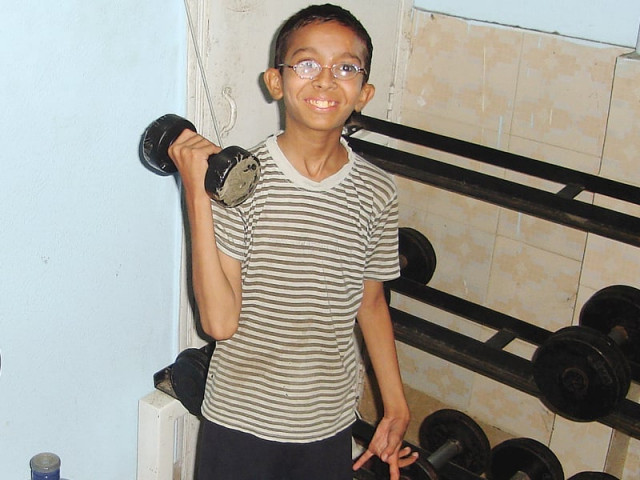
They’re a motley crew: milkmen from Landhi rub shoulders with real estate agents from Korangi. The sanitary workers of Bhains Colony jostle for space with clerical staff from Malir. Struggling students from Shah Faisal Colony compare biceps with the unemployed youth of Lyari. All of them have come to sweat it out at the Smart Fitness Zone.
Located at Shah Faisal Colony number 3, the Smart Fitness Zone comprises a single tube-lit room. Its bright blue walls are off-set by a maroon carpet that looks like it’s absorbed more than a few sweat stains. Ceiling fans whir in a futile attempt to dispel the heat and the clanking of gym machines fills the air.
A sign saying “Apnay saman ka khud khayal rakhain (take care of your belongings)”is scribbled in blue ink — traced and retraced to make it bold — and taped above the switch board. The people it is directed at belong to a host of professions. Some are carpenters, welders and tailors. Others run small grocery stores or butcher shops. Some are simply day labourers who work at different factories — when they can find work at all, that is.
Eleven year old Abdul Rehman — a student of class 8 visits the fitness centre daily after attending classes at a nearby coaching centre. Standing out among the blue-collar crowd is Mohammad Ali Adnan Kiyani works at a software house as a project manager and has recently joined the gym to burn excess fat and boost his metabolism. Then there’s 44-year-old Kaleem who is an advocate by profession and has been training for many years.
But despite their differences, they all speak the same language: the peculiar slang of the desi gym.
‘Hand practice’ they explain, refers to making your arms strong by lifting dumbbells. ‘Dola-makers’ is a word they use for boys obsessed with their biceps and triceps. Bench presses I learned are also known as ‘layto-meshq’ and equipment like calf-raises and squats are called ‘jaan larao’ and ‘kheencha taani’ machines.
The owner of the Smart Fitness Zone is a twenty-two-year-old man called Sohail Khan, who has won many bodybuilding titles such as Mr Club (at Intitkhab Gymnasium Shah Faisal Colony), Mr Shah Faisal and Mr Karachi (East).
“Usually, bodybuilders are classified into two main categories where the first category consists of 14 to 35-year-old boys while the second contains older gentlemen aged 35 or more. Boys in the first category usually join these clubs to beef up their muscles and shape them to look like Salman Khan. “Looking good in front of girls is their main motivation,” says Sohail.
Salman Khan, however, is not the only personality that the youngsters aspire to resemble. After talking to a few would-be Romeos I learned that the evergreen Arnold Schwarzenegger is still very much an icon. Although improving their romantic prospects is very much the motivation for the youngsters — for those above 35 (category two as Sohail puts it), the main motivation is staying healthy.
But the truly hardcore bodybuilders have to put their money where their mouth is — literally. Sohail says that the dedicated bodybuilder has to eat like an iron man as well, maximising his carbohydrate, protein and vitamin intake. According to Sohail, a professional bodybuilder must eat at least 1 kg of chicken, 8 to 10 eggs, 1 ½ kg of boiled potatoes and a few additional supplements daily.
“For any bodybuilder the ideal breakfast consists of porridge, 3-4 boiled eggs, red beans and at least half a dozen bananas. His lunch should consist of rice, salad leaves, chicken and red meat,” Sohail tells me as I mentally calculate that this one breakfast could feed a family for a day.
So how do people of obviously modest means manage to pay such hefty kitchen bills? Sohail admits that most are unable to follow the prescribed diet because it’s too expensive. In reality, these bodybuilders try to make do with what they have. Rather than spending money on pricey dietary programmes they become selective and avoid foods containing cholesterol, sugar and spice.
This ‘make do with what you have’ attitude extends far beyond diet though. Many regulars utilise their own home-made exercising equipments to practice at home as well.
One such piece of equipment is cemented dumbbells — made by putting concrete into empty ghee canisters. Some interesting alternatives to standard dumbbells are chairs, tables, iron stands and bicycles. Most of these gym addicts use olive oil to massage their entire body with and bathe in the Karachi sun for hours to get that perfect tan.
Apart from staying fit and looking good, bodybuilding enthusiasts say their workouts also help them avoid paan, gutka, cigarettes and niswaar. For those who live in more violent areas of the city, going to the gym helps them avoid not only the sporadic gunfire but also keeps them away from the local gangs. Focused on improving their ‘baadi’ and popping up their ‘machli’, our local bodybuilders stay true to their dumbbells.
If you peep into these bodybuilding centres, you will learn more about the average Pakistani than you ever did living on the ‘right’ side of the tracks. Perhaps the most significant correction to my stereotypical perspective was that it is not just the rich that care about physical appearances and are concerned about their health. In a country where health is given less than 1 per cent of share out of the total fiscal budget, I couldn’t help but appreciate the enthusiasm of these ‘gymists’ who prioritise fitness and health despite not being able to afford treadmills or elliptical trainers. Sometimes, enthusiasm and a ‘can-do’ attitude are all it takes.
Published in The Express Tribune, Sunday Magazine, July 31st, 2011.


















COMMENTS
Comments are moderated and generally will be posted if they are on-topic and not abusive.
For more information, please see our Comments FAQ